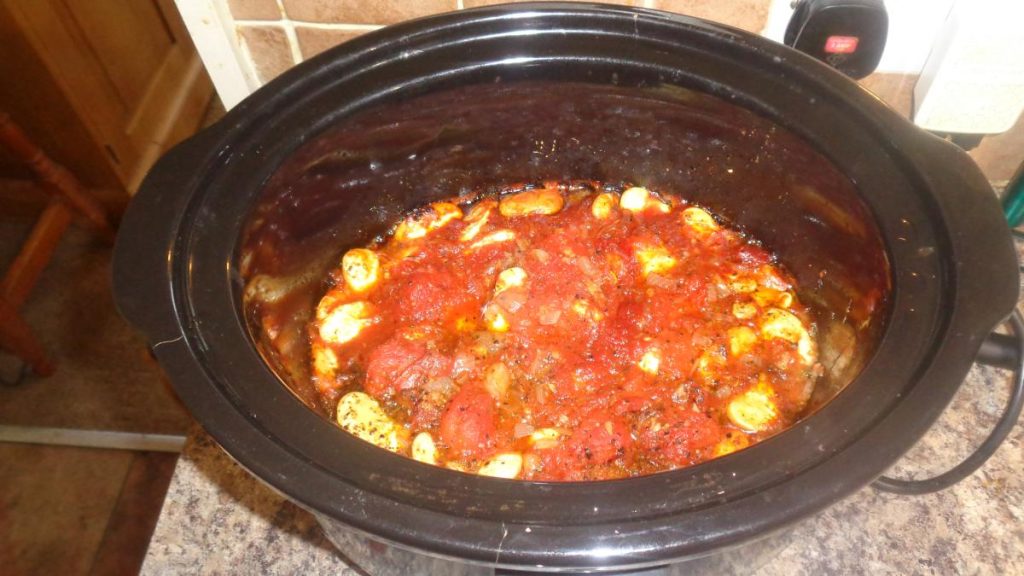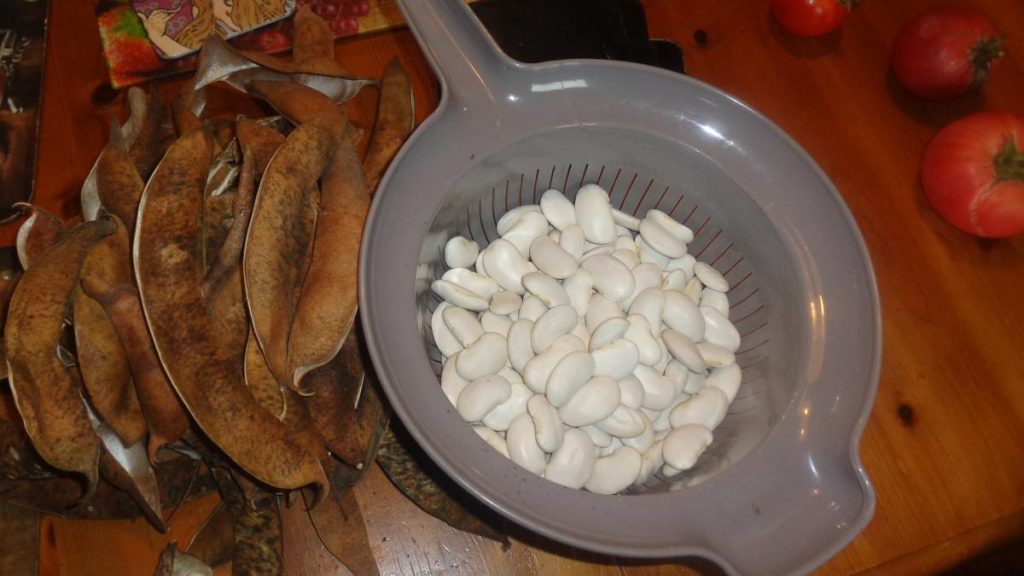Last year I lost a lot of our stored potatoes to rats and mice. Their seemed to be a lot about outside last year and some got into the old cow shed. It’s amazing how much damage rats can do without being obvious.
At one time our rodent controllers would have sorted them before they became a problem but now they’re, like me, getting older. Lotty used to be a prolific top hunter. In one day she presented us with 4 partly eaten rabbits but now she hunts her cat food which doesn’t run away.
So I built a large box from thick ply with ventilation to hopefully keep the potatoes safe. If I see any sign of them reappearing and trying to get into the storage box I’ll set up traps.
Being as we had a stormy day with horizontal rain, decided to go through the stored potatoes and put the latest harvest into store. Took all the sacks out of the box, emptied them and removed any that were rotting.
There weren’t many but it’s important to get them out quickly or the rot will spread. It doesn’t take long to lose the sackful.
Sarpo Axona
Next I went through the wheelbarrow full of Sarpo Axona. When they were lifted it was a dry day but the ground was sodden so they were fairly dirty. Settled down with a hand brush and cleaned each one.
OK, time consuming but it enabled me to detect any signs of blight developing in the tubers. Hopefully I’ve got them all but I’ll recheck for blight in a month.
Orla
The Orla also got the thick swept off. No blight but some had damage and holes where some bug had got in. Maybe 3 kilos but they’re in the ‘use first and soon’ bag. I don’t worry about insect damage with Axona. They’re quite dense and any damage is minimal plus damaged tubers tend to store well regardless. Not the same for the Orla.
So the potato store box is now absolutely full. And we’ve still got the Sarpo Mira to harvest.
Runner Beans
The runners are near the end. The pods are becoming very tough and woody if not harvested early. They’ve not done well for us this year but the French beans more than compensated.
Rather than digging them up, I’ll cut the foliage off at ground level and leave the roots. If the bean roots have nodules on them, these will contain nitrogen-fixing bacteria. Leaving the roots provides an inoculant for other legumes planted next year and adds a little nitrogen to the soil. The roots will rot down over time adding humus to the soil.
There is another option – just leaving the beans until the frosts come. Inside the pods the actual beans will develop. These can be used like haricots in dishes. I’m not doing that this year because I’ll want the space and I’ve grown gigante runner beans in the polytunnel.
Gigante (aka Gigandes) Runner Beans
Gigantes are a runner that is grown particularly for the bean. They’re the basis of the classic Greek dish, Gigantes Plaki. The white coloured beans are large, as the name suggests. They’ve a good flavour too.
Being as they’re grown for the bean which takes a while, they need a long warm season to finish. This is when the pods become dry and papery. Immature but developed beans can be kept in the freezer.
I grew them in the polytunnel which provided warmth but planted by the doors so they were available for insect pollination. That, at least worked to a degree. Lots of pods but the weather was very cool in July & August.
Sadly I had really poor germination of 7 plants (about 20%) but they’ve heavy croppers. There’s a lot still on the plants so hopefully we’ll double or triple the 500 grams yield from this first picking.
Recipe for Gigantes Plaki

Cooking Gigantes Plaki in the slow cooker.
500 gr Gigantes beans (If dried, pre-soak overnight)
2 white onions
4 or more cloves of garlic
800 gr tomatoes (or two tins chopped tomatoes)
1 or 2 tbsp tomato puree
0.5 ltr vegetable or chicken stock
Olive oil
1 tsp dried oregano
1 tsp dried thyme
1 tsp salt
1 tsp sugar
½ tsp chilli powder
- Chop the onions, crush the garlic and gently fry in olive oil until softened.
- Skin the tomatoes, chop or crush whichever is easiest.
- Put all the ingredients into a slow cooker and cook on low for 10 hours. Or cook on the stove top or in the oven on a very low heat. Great for haybox cooking.
- Check seasoning and add more salt if required and some black pepper at the end, serve with crusty rolls as a main dish or serve as a side dish.
Will keep in the fridge in an airtight container at 5ºC for up to 5 days. Will freeze for long term storage.
Cooking
I’ve been doing a bit in the kitchen when it’s raining. Val’s the expert but occasionally she lets me play with her toys. I tend to find recipes and then adapt them to suit what we have and how I feel.
This recipe for Greek Style Green Beans works well with runner beans that have been sliced finely with the bean slicer. I tend to use more tomato than the recipe calls for. It makes about three portions for us. One for now and two to freeze.
Being as we had a glut of tomatoes and courgettes, this recipe caught my eye: Tomato and Courgette Glut Soup Recipe. It became the basis for a glut soup by the time I’d added some ‘bottom of the fridge’ carrots and a few potatoes to thicken. No milk or cream though.
We went to the supermarket playing hunt the reductions and they’d got a large salmon head for 6p. There’s not much meat on a fish head but it added to a carrot, tomato and bits soup.





The Greek bean stew is terrific!
How do you store gigantes beans?. I’ve grown them for the first time as love eating them.
My recipe excludes chilli and sugar but includes dill and cinnamon.
I could have finished drying them in the dehydrator, then airtight jars or just frozen them. As it happens, made the Gigantes Plaki (which is freezable) and ate them.
Hi John, I do a similar thing, but with Cannellini beans, they are white like yours, but smaller and take a bit less time to ripen, we have more chance of getting a crop over here in chilly Lincolnshire. I use mine in Boston Baked Beans, very similar to your recipe except for fat bacon and black treacle. I dried mine in trays in the glasshouse in the pods. This year I managed 4.5Lbs (whatever that is in French) of beans after drying, so really happy and I always keep a couple of handfuls of seed beans for next year.
Don’t bother with any drying for the Greek beans- or any other podded beans for that matter; if you have space in your freezer of course. I always pick the Gigantes fresh (or Borlotti when I grow them) when the pods are flaccid and turning yellow but before they dry out.The beans will be full sized and slightly soft with a sheen on the skin. Bag up in convenient sizes (200g for me) and put in the freezer. When required defrost and use as you would fresh. This is a real treat in mid winter. They will keep until your harvest the next year and unlike dried beans do not become impossible to cook when stored for a long time. Out of curiosity I wonder what others yields have been? I noted I got 2.6kg shelled fresh beans from 12 plants last year, 216g per plant. This year 3.2kg from 14 plants, 229g per plant.
I’ve read that beans (e.g. kidney beans) can be toxic unless soaked over night and then roiling boiled (timings seem to vary between 10 and 30 mins) but just putting in the slow cooker isn’t sufficient, is this true? I can’t seem to find a “reliable” source about it. We cooked some of the bean seeds from our runners as the wet weather was threatening to rot them, they were large but the pods hadn’t dried out. We boiled for 10 mins first then added to a chilli that was cooked further but both of us had stomach “grumbles” the next day. We froze the remaining beans but my husband is minded to throw them out, I think this would be a waste but I’m worried we’ll maker ourselves ill. What are your thoughts on this? Did we harvest too early? We didn’t soak them.
I cover cooking beans in some detail in Low Cost Living from which I quote:
“Note: it is important to boil red kidney beans vigorously for 10 minutes after soaking, and then change the water. Boil again and discard the water. These beans contain a high level of haemagglutinins, which can cause a serious gastric upset. This process reduces the level to that found in all beans.”
Runner beans don’t contain more haemagglutinins than any other bean.
I have best of both , I grow White Lady runners so have masses of green beans to eat and salt down for the winter and large white beans to freeze when pods just turn yellow for stews, soups and hummus.
The gigantes are a lot bigger than normal runner bean beans. In weight about 4 times those of white emergo (bean for bean) and a great flavour as well.
As a woodturner I produce LOTS of woodshavings. These are clean and dry so I thought I would try storing my potatoes in plastic bins full of sawdust. Do you think this will work? Are there any things I need to watch out for?
Thanks,
Paul
Hi Paul – potatoes ‘breathe’ a lot so they need to be stored in such a way as to allow the moisture to escape (as covered in more depth in my books). Storing them in sawdust / shavings will mean the sawdust gets damp and I would expect lots of rot fairly quickly. Some root crops like carrots can be stored in sawdust. So basically, I wouldn’t store potatoes in sawdust.